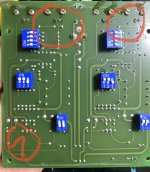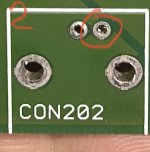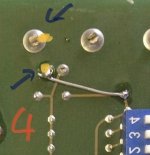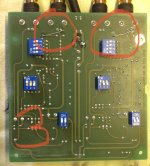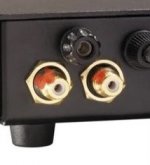Hello!
a client of mine brought me his Lehmann Black Cube SE ii for repair, recap and revision update. It had a blown THAT1510. After I changed the THAT and the eight electrolytics (with exactly the same Chemicon ones), I was challenged with the revision update. My client‘s cube is an early one with a very low serial number. Seems like after some years a slight modification was made by the designer, by soldering the input capacitor directly to the negative cartridge input of each channel, which is (or was previously) grounded.
Can anyone with a newer Cube do some measurements?
I have attached two fotos of my client’s cube without any midification (Photo 1 &2). Photo 1 does not have any „bridge“ soldered at the input and Photo 2 shows (the back of the RCA connector) that the negative cartridge RCA inputs are connected to ground.
In a photo downloaded from the internet (Photo 3) you see a factory modified newer version with „bridge“ installed.
My question is if the designer, not only installed the „bridge“ between input capacitor and ground, but if he also disconnected the ground from the cartridge input RCAs in this newer revision:
I would need help of someone who owns a newer model, to measure between the negative input and ground, to see if there is a connection (yellow dots photo 4)
Any help would be appreciated by my client and anyone else trying to improve their cute little cubes
Thank you!
a client of mine brought me his Lehmann Black Cube SE ii for repair, recap and revision update. It had a blown THAT1510. After I changed the THAT and the eight electrolytics (with exactly the same Chemicon ones), I was challenged with the revision update. My client‘s cube is an early one with a very low serial number. Seems like after some years a slight modification was made by the designer, by soldering the input capacitor directly to the negative cartridge input of each channel, which is (or was previously) grounded.
Can anyone with a newer Cube do some measurements?
I have attached two fotos of my client’s cube without any midification (Photo 1 &2). Photo 1 does not have any „bridge“ soldered at the input and Photo 2 shows (the back of the RCA connector) that the negative cartridge RCA inputs are connected to ground.
In a photo downloaded from the internet (Photo 3) you see a factory modified newer version with „bridge“ installed.
My question is if the designer, not only installed the „bridge“ between input capacitor and ground, but if he also disconnected the ground from the cartridge input RCAs in this newer revision:
I would need help of someone who owns a newer model, to measure between the negative input and ground, to see if there is a connection (yellow dots photo 4)
Any help would be appreciated by my client and anyone else trying to improve their cute little cubes
Thank you!
Attachments
Last edited:
Dear all,
I'm expecting to do a complete maintenance of a Lehmann CUBE SE II. Does some one have a schematic of this preamp?
Thank you very much.
Jazzyj
I'm expecting to do a complete maintenance of a Lehmann CUBE SE II. Does some one have a schematic of this preamp?
Thank you very much.
Jazzyj
On my Cube SE and my Cube SE II the "negative" phono inputs (RCA input outer ring) are NOT connected to ground (RCA output outer ring).
Since most Moving Coil cartridges (and maybe some MM & MI, too) are symmetrical the "negative" input (outer ring of RCA in) is no meant to be shortened to ground (outer ring of RCA output). Leaving is symmetrical improves the S/N ratio and avoids humming.
I modded my Black Cube SE with a symmetrical XLR input which is directly connected to the turntable, so there is no phono cable that could negatively affect the delicate phono signal.
Since most Moving Coil cartridges (and maybe some MM & MI, too) are symmetrical the "negative" input (outer ring of RCA in) is no meant to be shortened to ground (outer ring of RCA output). Leaving is symmetrical improves the S/N ratio and avoids humming.
I modded my Black Cube SE with a symmetrical XLR input which is directly connected to the turntable, so there is no phono cable that could negatively affect the delicate phono signal.
